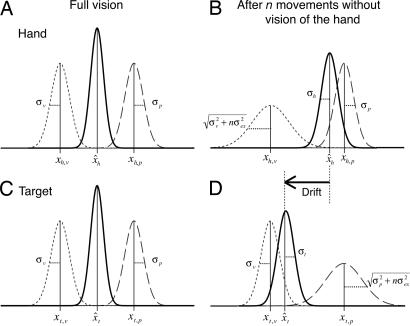Fig. 1.
The model. The Gaussian curves represent the hypothesized probability density functions of proprioceptive (dashed), visual (dotted), and combined (continuous) estimates of position. (A and C) When the hand is at the target with full vision, the positions of both the hand (A) and target (C) are based on the optimal combination of proprioceptive and visual estimates. (B) We propose that if the hand disappears from view, the visual estimate of its position gradually becomes less precise with each movement that is made. The combined estimate of the location of the hand will therefore rely less on vision, so that the combined estimate shifts toward the proprioceptive estimate, with a reduction in precision. (D) At the same time, the proprioceptive estimate of target location becomes less precise. The combined estimate of the target location will therefore rely less on proprioception, so that the combined estimate shifts toward the visual estimate, with a reduction in precision. To keep the perceived position of the hand on target, the hand will drift over a distance equal to the difference between the two combined estimates (black arrow).

